How to practice the stability of the body in water. Today, we teach you one of the most useful and simplest techniques-360° kicking practice.

When practicing, you can practice kicking in four directions in turn, and you can do it 2-3 times in each direction. You can practice diving in the water or kicking on the water, which is conducive to improving the kicking efficiency. In the beginning, keep the advancing direction in a straight line instead of straggling up and down from left to right. Stretch your hands forward and clamp your body, and keep your upper body from shaking during the advancing process. When the front half of your body remains firm and stable, it is beneficial to reduce the forward resistance.
When practicing skillfully, you can try the weight-bearing exercise, hold about 1kg dumbbells or mineral water bottles filled with water in your hands, and keep your body stable while kicking. Carrying out 360-degree underwater diving leg-beating exercise with load is beneficial to improve the speed of starting and turning.

When practicing physical stability, it is recommended to change the direction after 1-2 movements. Because under the load condition, the hand stretching forward in the supine position will shake up and down unconsciously, which will easily destroy the streamlined sense of water. At the same time, if you deviate from a straight line when you kick your legs, it means that the front of your body is obviously shaking. You should streamline your body on the shore, and then re-enter the water for practice.
Next: How to Choose Swimwear for Children?
Previous: Tips about Water Sense